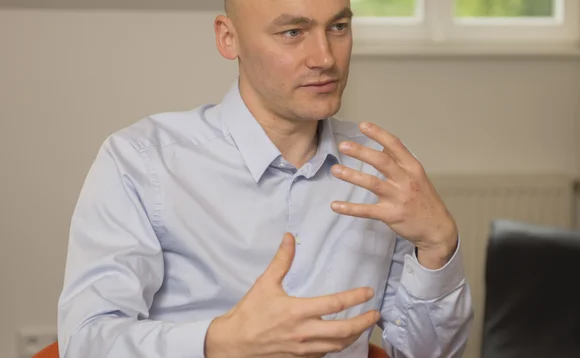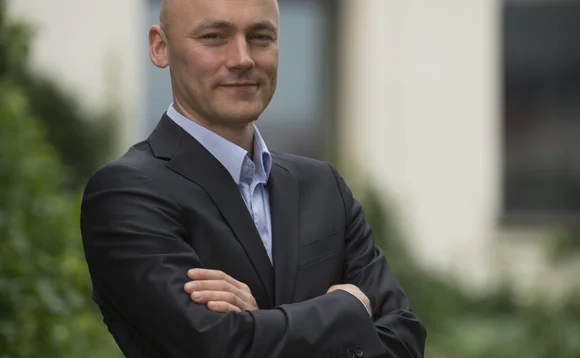Bohemian Rhapsody: CIO Michal Sanak Leads Prague's RSJ with Smart Speed






The Nürburgring, one of Europe’s legendary racetracks, has offered tight curves and undulations to Formula One (F1) greats since the early 1920s. Today, the course, in Germany’s central Rhineland region, is open for “public sessions” to street-legal cars as well. Its Nordschleife (North Loop), once famously described, and known ever since, as the “Green Hell,” is not for the faint of heart, and various modifications—even an entire new circuit—have been built over the years to address growing concerns about its safety. Still, the simple thrill remains in taming the beast: to complete a single lap in as fast a time as possible, and then beat that time again. As F1 greats Lewis Hamilton and Mark Webber said of Nürburgring this summer, it still has an “old classic” feel—even if the course has changed.
Here in Prague, about 420 miles to Nürburg’s east, RSJ’s CIO Michal Sanak says he runs the German track a few times a year. The intense concentration required, he claims, actually relaxes him. “It removes everything else,” he says. And it's a fitting hobby, and venue, for one of the pioneers of futures market-making. Like the Nürburgring, high-speed trading needs some tweaking; yet the impetus to remain in the space must stay the same. Sanak’s all for it. Like everything he has done to build this proprietary trading firm into one of the world’s largest algorithmic traders, though, it has to be done exactingly.
From an Attic
Known for its architectural beauty and Holy Roman Emperors, literary giants like Franz Kafka, the Velvet Revolution, and a veritable mélange of contemporary culture—not to mention Pilsner—Prague is a quintessential European capital, though far from a global financial center. Sanak, who joined RSJ in 2002 shortly after finishing his university studies in economics, still fondly remembers the day a local utility installed Ethernet cables underneath the gently ascending cobblestone street outside the firm’s offices, right next to the US embassy, when RSJ moved from its original home in nearby Plzen. “So often, they say these things start in a garage; we started making markets in an attic,” Sanak says. Sure enough, that same cavernous attic—its vaulted ceilings now retrofitted with dozens of trading screens—still houses the firm’s proprietary trading desks. Much else, though, has changed.
“When I joined, RSJ was already doing some asset management strategies around short-term interest-rate futures, and the idea emerged that it would be sensible to consider market-making algorithmically. There was enough liquidity, we thought, but until then, it was really still point-and-click screen trading," Sanak says. "For my part, it was meant to be a half-year-long project. There was only one other person with me programming the system, in Delphi, but I ended up on both sides, the trading itself, as well as looking after the black box. Originally, we had direct market access routed through a broker to NYSE Liffe, but with nothing co-located. So, in the early years, when US unemployment numbers were published at 2:30 in the afternoon here, all of a sudden things would get a little bit crazy.”
Gleaning a “tiny slice” of millions of trades, it turned out, could justify the high fixed costs. A new head developer, with a team of three in tow, joined Sanak in 2006 to re-architect the system—this time using C# and .Net stacks at home, and springing for faster switches for its co-located containers at Liffe, Eurex in Frankfurt, and the CME. That same foundation now remains as the shop trades over 50 million lots combined across those three venues quarterly—averaging about one million per day—with annual turnover topping $100 trillion.
“We’ve played with other languages and tools, but we can run our models on existing applications and commodity hardware, mostly, because our focus is on being smart, rather than shaving off every last microsecond.”
“People are surprised that we still use those systems and stack today, because everybody thinks you really have to be technologically ‘hard core’ to do algo trading,” Sanak says. “Of course, we’ve played with other languages and tools, but we can run our models on existing applications and commodity hardware, mostly, because our focus is on being smart, rather than shaving off every last microsecond. The way we view it is that technology shouldn’t make for a bottleneck in the generation of profit, and the approach therefore is to provide infrastructure that is not only latency-aware, but also resilient. We’re obviously worried about an algo going crazy on the market, and we build to that—systems with numerous safety checks such that an outgoing order has to pass several gatekeepers, whether on order size; price; its dynamics, like how many have been placed in the last second; the number of immediate-or-cancel (IOC) duration orders; and the number of limit orders. It’s for our own safety and for the market. We just wouldn’t deploy a model that doesn’t have that wrapped around it.”
Fundamentals
Like most prop traders, RSJ’s market-making strategies are based around advanced mathematics and statistical modeling. But according to Sanak, there are at least two ways to deploy them, each with subsequent technology implications.
“One method is to run a bunch of data, throw analysis on top from which a model then emerges, but that isn’t the way we work,” he says. “Instead, ours is a fundamental approach, where you start with a mathematical idea of how to systematically make money, and then collaborate on a model and introduce historical sets of market data to hone it from there. If you take data alone and produce models from it, you might not understand what you’re doing. That’s not a problem for a robust market, it won’t necessarily hurt—but it is problematic for the firm. For us, we want to work with robust models that are long-term applicable, ideally longer term than the investment banks’ algos, even if they’re for specific situations like roll periods. We would rather do that than happen across some information or an anomaly from a dataset, build to it, only to then not understand why it’s stopped working the next day.”
That sense of discipline guides RSJ’s 30 traders, too—whose role, as Sanak describes it, is to support the algo, rather than the other way around. “Their role is in closely monitoring the system, knowing very well how the system should behave, spotting market conditions the model isn’t constructed for, what to tweak, when to leave a market entirely, and which one of those reactions to have based on news coming out,” Sanak says. “But across the firm, very few people are not engaged with the technology is some way. Traders at some shops will be dedicated to certain markets, and plug an idea into the algo infrastructure, toy with it a bit, and then deploy it straight away. Here, the statisticians, the traders, and the developers all come up with the model cooperatively. They all provide feedback and some parameters are invariably tweaked and then put into production if they are found to better predict a price, but the role of building the model isn’t the traders’, so much as the whole company’s.”
Slow Change
Sanak, now one of RSJ’s senior-most shareholders at only 34 years old, says his job is to give all those different constituents, including his own 25 staff, the technology they need. “It’s not just the trading system itself, anymore—the data analysis platform is just as big a responsibility,” he says.
In constructing the technical ability to collect and analyze data on millions of trades daily in Eurodollar futures and other highly-liquid products, Sanak believes his role has shifted a bit in recent years, from choosing the right internal builders to hire—as in 2006—to choosing the right provider. “We have a ton of historical data running back several months, and we began building a distributed file system to store that, and frankly we realized it would prove too much work,” he explains of a recent decision to implement Kx Systems’ kdb+ high-performance database and time-series processor earlier this year.
“It’s true that we’ve acquired many of these external relationships just lately, and I do think it has something to do with better quality becoming more available now than in the past,” he says. “We’ve always thought the best way to go is to build it ourselves, under our control, but that’s slowly changing. Especially as we push into other correlated markets like cash equities, bonds, and rate swaps, the more developers and analysts we have free to tackle that, rather than data storage or a latency-monitoring system, the better.”
Another example from the past year is RSJ’s installation of pure field programmable gate array (FPGA)-enabled feed handlers from NovaSparks. “There, too, we realized that it’s good for us to focus on things that we feel we’re unique at, and not building everything ourselves. Five years ago, if someone came to me with a handler claiming to be faster than ours, transferring between the network card and operating system, I would have been skeptical,” Sanak says. “But every time I talk to them, I’m surprised to find how well they know what they’re doing, and listening to us to design for what we need.”
Playground Instincts
Still more reason for distributing those internal IT tasks outward is that stability in the market, or the “playground” as Sanak puts it, needs far more careful attention today than it once did. As one of the exchanges’ biggest customers, RSJ’s senior staff consults continuously with them on market data provision, order-entry feeds, and discusses safety mechanisms, as well. “One recent example was working with one venue on how it should behave when a member sends in an IOC, which erroneously matches an order the member already has in the market,” Sanak explains. “So you’re on a limit order at a price, and the algo thinks you should act at that price in a particular way, but instead you actually match with yourself. It essentially creates a wash, which is illegal—but through that cooperation, it was decided to either reject the IOC, or automatically cancel the existing order.”
Most of the exchanges have these kinds of mechanisms, he says, adding that some are robust, some a little less so. “Certain markets are stable in structure, others more volatile,” he says. “For us, the key is to know which is which, and build our own checks for those things that aren’t covered. What’s changed is that in 2002, with eight people, we didn’t really have to think about that, and at the time, it worked. But new firms in the market today often won’t have the resources we’ve developed over years to do the things that, frankly, aren’t too much fun, but are really required now. So it’s important for the markets that we are all somehow resistant to ‘newcomer’ risk, and in my view, this comes back to the exchanges. Anything can go wrong. Programmers and analysts make mistakes, and obviously you have traders watching systems online, but how quickly can they really react? In seconds, maybe, but in seconds, it could be too late.”
New Ideas
This year will no doubt present its share of challenges. Certain regulators, for example, still want to cut high-speed trading down to size, if not out of some national markets entirely, while high-frequency trading (HFT) snipers will continue to peruse the markets looking for size to take advantage of, and in so doing, tarnish the name of legitimate liquidity providers in the process. For a proud firm like RSJ—one about to move into a bigger home this year; one that has carried on the tradition of providing direct shareholder stakes to its lead developers, and whose co-founder Karel Janecek, after recently retiring, has even spearheaded the Czech Republic’s anti-corruption fund—the best thing to do is serve as an obvious, and vocal, example.
“Both in the US and especially in Europe, we watch the whole of the legislative infrastructure closely,” Sanak says. “We’ve already been involved as a member of the Futures Industry Association’s (FIA’s) European Principal Traders Association (EPTA), trying to bring new ideas to those who are creating those new rules, and dispel the perception that algorithmic and HFT traders are secretive, existing under the radar, and just throwing orders into the market to destroy it.”
Financial transaction taxes—which failed to be implemented across the continent, but are still being considered under enhanced cooperation in a number of countries—and how MiFID might regulate algo traders, represent a pair of areas where a disproportionate response could spell the end of market-making in certain products. “It just depends on how it’s implemented and where. Had it been the way the European Commission originally proposed, with a tax on a derivative of 0.1 percent even where the notional value of that derivative, especially in rates, is huge, we would have to quit trading because the tax is thousands of times greater than the profit for us,” Sanak says.
Self-Preservation
Like the Nürburgring, it’s a matter of doing fast smarter, without abandoning the sport altogether. Sanak would never put competition-grade brake pads on the vehicle he takes to work—his bicycle—because the uphill ride home doesn’t demand them. But without them at the German racetrack? “They would burn after one lap,” he says.
In both cases, the care reflects the risk, and Sanak intends for RSJ and its systems’ resilience to be evidence of the same sort of shrewd, self-preserving calculus. “Obviously, to threaten the integrity of the market would be, quite simply, to go against ourselves,” he says. Increasingly so.
Michal Sanak Fundamental Data
Name: Michal Sanak
Born: 1979
Company: RSJ in Prague
Title: CIO and shareholder
Number of IT Staff: About 30
Tenure: Joined RSJ in 2002
Education: Studied economics at the University of Economics in Prague
Favorite Hobby: Closed-circuit street racing
Favorite Vehicles: BMW M3 and a bike, which is taken to the office
Only users who have a paid subscription or are part of a corporate subscription are able to print or copy content.
To access these options, along with all other subscription benefits, please contact info@waterstechnology.com or view our subscription options here: http://subscriptions.waterstechnology.com/subscribe
You are currently unable to print this content. Please contact info@waterstechnology.com to find out more.
You are currently unable to copy this content. Please contact info@waterstechnology.com to find out more.
Copyright Infopro Digital Limited. All rights reserved.
As outlined in our terms and conditions, https://www.infopro-digital.com/terms-and-conditions/subscriptions/ (point 2.4), printing is limited to a single copy.
If you would like to purchase additional rights please email info@waterstechnology.com
Copyright Infopro Digital Limited. All rights reserved.
You may share this content using our article tools. As outlined in our terms and conditions, https://www.infopro-digital.com/terms-and-conditions/subscriptions/ (clause 2.4), an Authorised User may only make one copy of the materials for their own personal use. You must also comply with the restrictions in clause 2.5.
If you would like to purchase additional rights please email info@waterstechnology.com
More on Emerging Technologies
OCC’s security chief on generative AI with guardrails
Clearing house looks to scale technology across risk and data operations—but safety is still the watchword.
Bank of America reduces, reuses, and recycles tech for markets division
Voice of the CTO: When it comes to the old build, buy, or borrow debate, Ashok Krishnan and his team are increasingly leaning into repurposing tech that is tried and true.
Waters Wavelength Ep. 313: FIS Global’s Jon Hodges
This week, Jon Hodges, head of trading and asset services for Apac at FIS Global, joins the podcast to talk about how firms in Asia-Pacific approach AI and data.
Project Condor: Inside the data exercise expanding Man Group’s universe
Voice of the CTO: The investment management firm is strategically restructuring its data and trading architecture.
BNP Paribas explores GenAI for securities services business
The bank recently released a new web app for its client portal to modernize its tech stack.
Bank of America and AI, exchanges feud with researchers, a potential EU tax on US tech, and more
The Waters Cooler: Broadridge settles repos in real time, Market Structure Partners strikes back at European exchanges, and a scandal unfolds in Boston in this week’s news roundup.
Bloomberg rolls out GenAI-powered Document Insights
The data giant’s newest generative AI tool allows analysts to query documents using a natural-language interface.
Tape bids, algorithmic trading, tariffs fallout and more
The Waters Cooler: Bloomberg integrates events data, SimCorp and TSImagine help out asset managers, and Big xyt makes good on its consolidated tape bid in this week’s news roundup.







